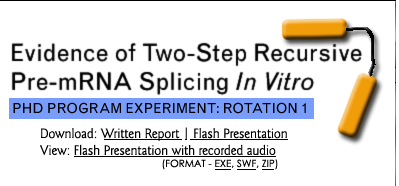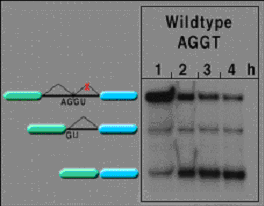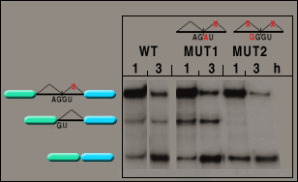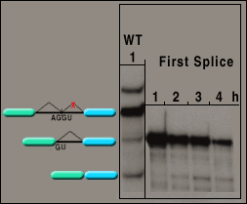|
 |
RESULTS: The first step of this experiment was to splice the full lenght mRNA to determine if splicing intermediates were formed. The results of the experiment are pictured at right. The experiment was carried out over 4 hours. At each hour the splicing reaction was stopped. Analysis of this result reveals that the primary mRNA in fact splices down to the secondary mRNA as bands exist at the distance that is expected for them. Besides noting the locations of the bands, comparing the bands over time provides additional information. Looking at the top row of bands for the primary mRNA, it is noticed that the strenght of the band is decreasing. This is indicative of a decrease in the amount of the mRNA over time, as would be expected due to it being spliced into smaller pieces. It is also noted that the amount of final product is increasing as time progresses. T Finally, it must be shown that the intermediate splicing product can itself be spliced down to the final product. In this experiment, the intermediate splice mRNA was run for 4 hours and samples collected every hour. The results are listed to the right and this intermediate mRNA is compared against a full lenght mRNA. The mass of bands for the intermediate splice aligns with the intermediate splice of the full lenght and it is noted that the band shrinks over the course of time indicating that the intermediate substrate could potentially be used in splicing reactions. Examining the location where the final product is found, there exist a band for the intermediate splice mRNA that is increasing in darkness over time. This provides evidence that final product is accumulating over the course of time. |


 he second step of this experiment is to show that by creating mutations in the splicing site of the primary mRNA that it would prevent the formation of the intermediate mRNA. In this experiment pictured on right, samples were run for 3 hours and the results were taken at 1 and 3 hours. WT represents "wild type" or the unmutated version. MUT1 is mutant 1, features a mutation but is not expected to prevent formation of splicing intermediates. MUT2 has a mutation that is expected to prevent formation. As we review these results we see clear bands representing the splicing intermediate in the WT and MUT1 samples. However there is a clear absence of a band in this location for MUT2 and it suggest that this splicing site is required for the recursive splicing model.
he second step of this experiment is to show that by creating mutations in the splicing site of the primary mRNA that it would prevent the formation of the intermediate mRNA. In this experiment pictured on right, samples were run for 3 hours and the results were taken at 1 and 3 hours. WT represents "wild type" or the unmutated version. MUT1 is mutant 1, features a mutation but is not expected to prevent formation of splicing intermediates. MUT2 has a mutation that is expected to prevent formation. As we review these results we see clear bands representing the splicing intermediate in the WT and MUT1 samples. However there is a clear absence of a band in this location for MUT2 and it suggest that this splicing site is required for the recursive splicing model.